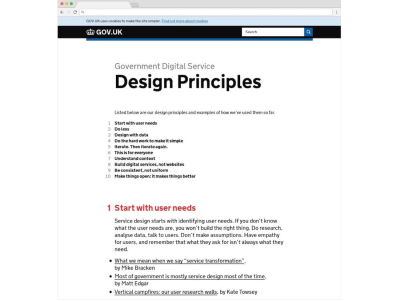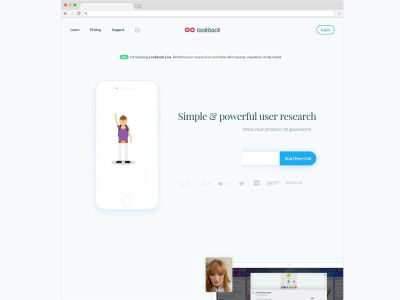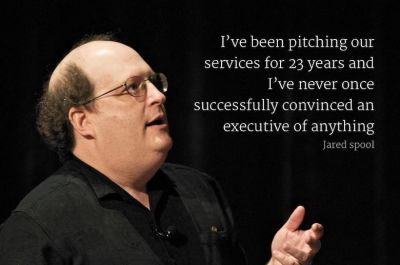How To Spark A UX Revolution
It feels like everywhere I turn somebody is saying that user experience is the next frontier in business, that we have moved beyond the age of features to creating outstanding experiences.
But for many of us who work on in-house teams, the reality feels a million miles away from this. Getting management to understand the importance of user experience seems so tough. Even colleagues don’t seem to see the benefit. For those of us in-house, how are we going to get to this golden age of user experience design that people keep promising us?

After all, design-led companies have outperformed the rest of the market by 228% over 10 years. 89% of customers say they’ve stopped doing business with a company after a bad experience. Why then aren’t companies falling over themselves to create a better experience? Why is your job so frustrating at times?
The answer is simple. Change is hard. The world has changed. Digital has changed it, and people’s expectations are higher than ever. People and not companies now have the power. Yet many managers still live in the past, in a world of mass production and mass market.
We need to provide the wake-up call our clients and management need. We need to help them realize the potential of user experience design, its potential to reshape their business and provide a competitive advantage. But how?
First, we need to realize we cannot do it alone.
Find Like-Minded People
Sometimes we designers are our own worst enemy. We sit around moaning that nobody gets it, that nobody understands. But that isn’t true. Designers are not the only people who see the value of a great customer experience. Others might not know the term UX, but that doesn’t mean they don’t care.
Marketers and sales people understand; they know that a satisfied customer is the best form of advertising. Customer support staff know; they know that happy customers are less likely to call them with problems. Even the finance people get it; they understand that happy customers are less likely to return products, that they are more likely to make repeat purchases.
Neither are we the only people with insights into the user. Marketers have done their market research. Customer-support staff talk to customers every day.
If we want to bring about change in our organization, we cannot continue to be the lone wolf. We need to find allies. We need to bring together all those who care about the user’s experience.
This was part of the reason why Google’s culture shifted from being engineering focused to embracing the importance of design. Designers across the company started to reach out to each other. They started to talk to one another and united around shared values. You need to do the same.
Take the time to seek out people who share your belief in customer experience and start talking to them. Create a Slack channel or mailing list. Get together over lunch. Keep in touch. Share experiences and ideas.
Of course, chatting over lunch or in Slack isn’t going to bring about change. For that, you need to start a movement. You need to unite the group around a common goal, around a common cause.
Unite Around A Cause
There is power in numbers. Management is more likely to listen to you if you have a clear, consistent message.
Once you have formed your group, outline some principles on how the company could work to create a better user experience.
But be careful. This shouldn’t turn into a list of everything you perceive to be wrong with the company. That would do nothing but anger and threaten. Also, managers spend their lives hearing problems from employees. If you want to get their attention, you need to be more positive.
Instead, create a positive set of values that will encourage change, the kind of values that put user needs at the centre of decision-making, values such as “Design with data” and “If in doubt, test.”

There is no shortage of principles to inspire you, from the Government Digital Service in the UK to Google. In fact, Jeremy Keith has kindly compiled a list of them over on his website.
On day one, these principles aren’t going to have teeth. Management won’t have bought into them. They aren’t something you can enforce. All of that can come later. For now, they will unite the group and strengthen your resolve.
But most of all, they will give you a clear message to take to the rest of the company, a message that has the customer at its heart.
Raise The Profile Of Customers
The next step in your campaign for change is to raise the profile of the customer. It is shocking how little most organizations talk about customer needs — or at least talk about it in any meaningful way.
Take a look at the average office wall. Companies cover them with certificates, product shots, executives shaking hands and motivational posters — all inward-looking, all focusing on the achievements of the organization. Rarely do you see the user.
Meanwhile, they shove the things that give insights into the user in a drawer somewhere: the personas, customer journey maps and user research. Why aren’t these things on the wall? Why don’t you make sure they are.
Instead of lecturing colleagues about users, make it impossible to ignore them. Turn that user research into attractive infographics. Cover the walls of your office with them. Sneak in at night and replace those inward-looking wall hangings. Put personas, data and quotes about the user in their place.

But don’t stop there. Open up those usability sessions that you run (you do run them, don’t you?) and invite anybody to come along. Bribe them with food if you have to, anything to get them to see users firsthand.
Failing that, record those sessions. Edit together the highlights, and distribute the video to colleagues.

Also, start sharing best practices on the user experience. Send out a weekly newsletter. Use it to highlight what others are doing to improve the customer experience. Quote experts and research in the field. Share testimonials from customers you have interviewed.
Consider running lunchtime sessions, presentations in which you share best practices, but also in which you share your research. Once again, lay out some food to encourage people to attend. If the budget allows, bring in the occasional outside speaker, someone who will add some credibility to the proceedings.
In short, create some buzz around the customer experience. Treat it like a product launch or marketing campaign. Get imaginative and make it impossible for your colleagues to escape the user.
But don’t target management. The biggest mistake I see people make is going to management for permission too soon. If you want to win over management, timing is everything. You need momentum and numbers behind you. You also need a clear vision of a better future.
Create A Vision Of The Future
As user experience designers, we tend to be visual people. We find it easy to imagine what could be. But not everybody is like that. Most people need to see the potential, rather than be told.
If we want management to care, we need to excite them. To excite them, we need to show them a better future, something they can see potential in. That is why, before we ever approach management, we need to have something to show.
Employees at Disney had an idea. They envisioned a MagicBand that visitors to their parks would wear. The band would allow visitors to pay for anything, unlock their hotel room door and more. It would track one’s position so that Mickey could walk up to a child and wish them a happy birthday by name. It would allow a maître d’ to greet a patron personally as they arrived at the restaurant.

Winning over the executives would be tough. The investment was going to be large. So, they built a prototype. They converted an empty warehouse into a cardboard park. It had rides and hotel rooms and restaurants, everything they needed to show their idea.
They invited along the executives. They strapped paper prototypes of the MagicBand around their wrists. They then guided them around the cardboard park, giving them a sense of what the experience would be like.
By showing the executives, rather than telling them, they created excitement. That is what you need to do. A document or slide presentation isn’t going to do the job.
Build a prototype showing management a better way. Visualize a better user journey. Do whatever it takes to excite them about the potential.
You might have to work evenings to get it done. You might have to squeeze it between other work. But it will be worth it when you finally approach management to get them on board.
Approach Management
You are going to need management’s support if you want to see the company become user-centric. No amount of grassroots change is going to get the job done without them. So, when the moment comes, you need to make sure you don’t blow it.
First, put off talking to management until you have to. The longer you leave it, the better prepared you will be, the more momentum among colleagues will be behind you. Remember that management’s job is to shoot down half-baked ideas, so we want to give them no excuse.
Your prototype or vision of the future will help, but it won’t be enough. Some managers get excited by concepts and potential. Others are more risk-averse and prefer hard numbers. That is why you will want some data to back up your proposal. If possible, test the prototype with real users.
You can further mitigate risk by referring to outside data and experts. Third-party sources add credibility to your argument. Management will also consider them more impartial. That is why many choose to bring in an external consultant at this stage.
As you sit down to talk to management, bear in mind one important thing: They don’t care about the user experience, and no amount of arguing will change that. Tim Cook once said:
“Most business models have focused on self interest instead of user experience.”
— Tim Cook
Although you want to change that in the long term, you are not there yet. So, focusing on improvements to the user experience will not convince them.
Instead, we need to learn from Jared Spool. In his article “Why I Can’t Convince Executives to Invest in UX (and Neither Can You),” he gets to the heart of the issue:
“You can find out what your executives are already convinced of. If they are any good at what they do, they likely have something they want to improve. It’s likely to be related to improving revenues, reducing costs, increasing the number of new customers, increasing the sales from existing customers, or increasing shareholder value. Good UX can help with each of those things.”
— Jared Spool

Whatever you want to do to improve the user experience, frame it with what management cares about. If you don’t know what that is, find out. Dig out that company strategy you never bothered to read. That will tell you exactly what they want to achieve. Now all you need to do is show how your ideas will move the company closer to those goals.
Of course, the big question is, what should you ask management for? What is it you want them to do? This is where things can go wrong.
If you ask them for wholesale change, you will overwhelm them. If you ask for a big investment, they will be hesitant. That would require you to have a very compelling case or a great track record of delivering on big-budget projects.
Instead, start small. Earn their trust and build their confidence. Avoid overwhelming them.
Start by outlining your vision of the future. Get them excited. But to avoid overwhelming them, you need to make the next step easy.
Instead of asking for wholesale change, ask them to take one small step. Ask permission to build a proof of concept, something to show that user experience can make a difference to the business.
Begin With A Proof Of Concept
A proof of concept is a chance to prove yourself and user experience design to management. It will show how you can make a difference to the business. So, getting the right proof of concept is critical.
There are three considerations in picking a project:
- You need a project that is not expensive to build. Otherwise, management will be hesitant to say yes.
- You need something that supports one of management’s goals and that uses UX design to achieve it.
- You want something measurable, so that you can prove whether the project works.
For example, suppose management wants to increase the number of leads the company gets. You might agree to run a project that encourages newsletter signups, but to run it in a way that provides value to the user, rather than tricking people into signing up. This will give you a chance to show that putting the user first provides better returns.
This project would work well because you can tie it to a management goal. It would also be inexpensive to build, and its effectiveness would be easy to measure.
The key to a successful proof of concept is to gather as much evidence of success as possible. Measure relentlessly. Even trial more than one approach for comparison. This will provide the evidence that management needs to be confident in you and in the benefits of user experience. It will give them the confidence to take the next step.
This Is A Marathon, Not A Sprint
A proof of concept is still only the beginning of the journey. You will need to run many such projects that guide management step by step towards your vision of the future.
Remember that this is a marathon and not a sprint. It will take time. It will be frustrating. But what is so obvious to you isn’t to everybody. They will need to go on that journey at their own pace. We need to stand with them, encouraging folks to take that next step, keeping them focused on the end goal.
That is why we cannot hope to do it alone. We need to unite with others around this common aim and vision of the future. We need to work hard to raise the profile of the customer and to approach management with care. But most of all, we need a plan, a plan that starts with some simple pilot projects to build trust, but also one that shows the importance of user experience.
You might conclude that it is not worth the hassle, that you would prefer to work somewhere that already gets it. That is fine. This role is not for everybody. But if you do persevere and change the culture of your company, you will become invaluable. It is the kind of journey that can make a career and transform a company. From my perspective at least, that is worth it.
Further Reading
- “Better User Experience With Storytelling,” Francisco Inchauste
- “How Functional Animation Helps Improve User Experience,” Nick Babich
- “Think Your App Is Beautiful? Not Without User Experience Design,” Dave Feldman
- “Are We Thinking About Digital All Wrong?,” Paul Boag
- “The Elements Of The Mobile User Experience,” Lyndon Cerejo








